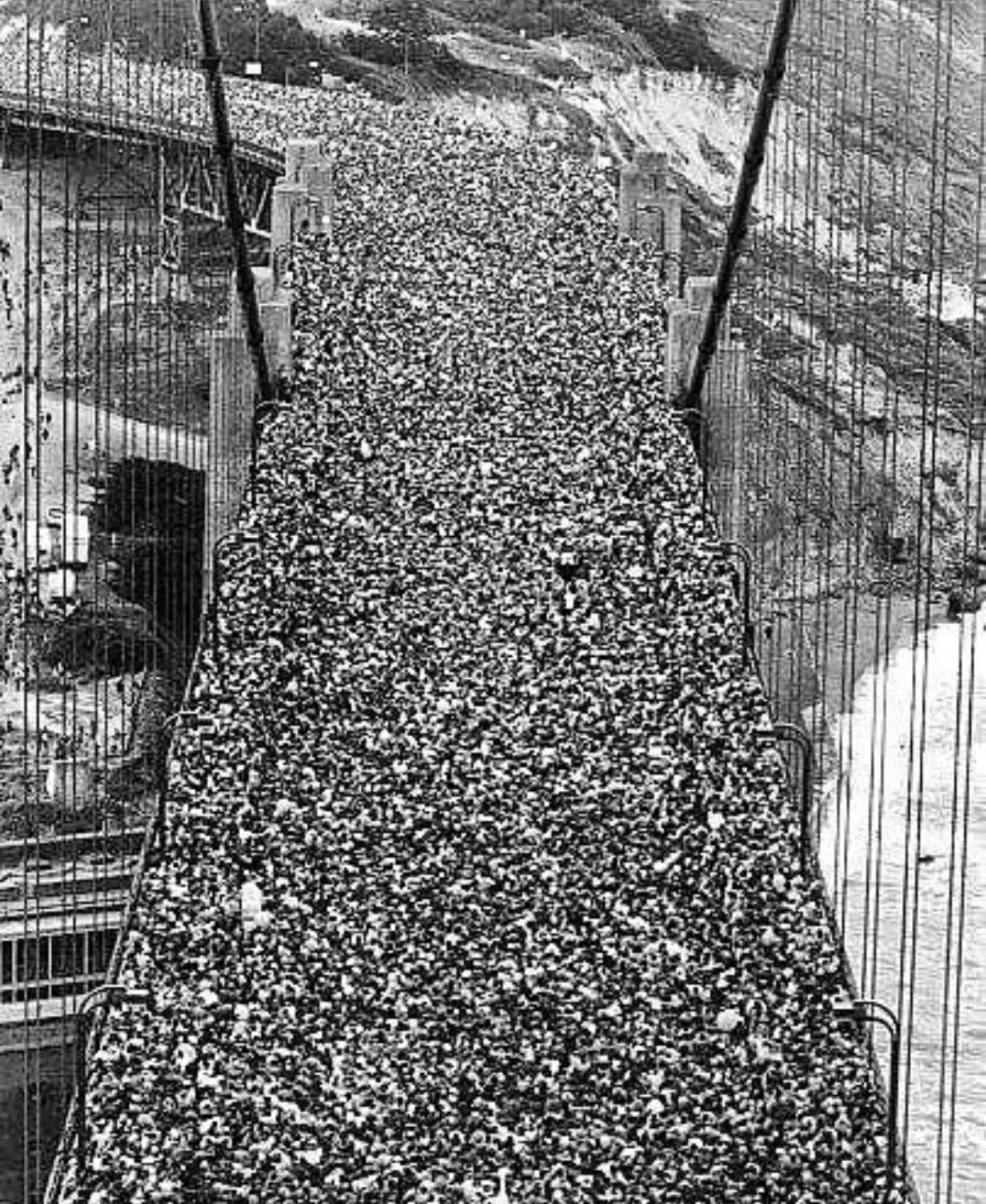Via Historic Vids (@historyinmemes):
That is the Golden Gate bridge when it opened to the public for the first time on May 27th, 1937.
I can’t imagine myself being in that big of a crowd packed together that closely. I have some questions about the load carrying capacity as well.


As far as the load capacity goes it held, in 1937 a crowd like that would be ok fine, not so much today, too many crazy folks now.
load-wise that can’t be anywhere near dangerous levels. let’s do a back of the bar napkin guesstimate…
humans are about as dense as water, give or take. a crowd like that has an average height the same as the average person at the time, which i don’t know what it was back then, so overestimate it at six foot even. multiply by the width and length of the bridge deck, then by the density of water. it’ll be plenty, but anywhere near the design load? i don’t think it should be.
i don’t know what the design load of the bridge was back then, either, but guesstimate that the same way. park the bridge full of bumper-to-bumper trucks as heavy as the traffic code allowed in ’37, and… damn, now i’d have to look up what _that_ would have been. and also how many traffic lanes the bridge deck was originally meant to have had. this is too much work for a bar napkin estimate.
back up; would a fully loaded cargo truck in the late thirties, max cargo legally allowed, have sank or not? because to outweigh the equivalent human crowd that would have taken up its space in bumper-to-bumper standstill traffic, it could not have floated as well as an average human. of course we _want_ to say it would’ve sank like a rock, but trucks _leak_ so that doesn’t necessarily tell us their density. my intuition is still that it would’ve been denser than water, but i have no solid data to back it.
okay, fall back on common sense. the max design load can’t reasonably have been _less_ than an easily foreseeable load instance. that crowd in the picture was easily foreseeable, and its weight was easy to calculate; it would have had to have been designed for, with margin.
About the only way I could see it being dangerous to the structure of the bridge is if, somehow, you could get the entire mass of people marching in time together, or jumping up-and-down in unison, or something like that. You can set up a horrific resonance that way, which is why columns of troops always go into “broken step” when crossing bridges.
I can’t even imagine what kind of tragedy would have occurred if a bunch of people had panicked and started to move, crushing the other people who had nowhere to go to get out of the way.
Was packed into a crowd. Once. Never again. As for the bridge’s load-bearing capacity: I’m fat, but fat is way less dense than a vehicle.
When you can’t reach your radio or your sidearm, the crowd is too tightly packed. Never again. Full disclosure: I was a volunteer at the time, and unarmed. Never again. BTW, great photo; gave me willies. NFW!
The original Golden Gate Bridge deck was concrete. In the early 1980s that deck was replaced with a formed steel and asphalt deck that significantly reduced the weight of the deck. The American Welding Society’s Welding Journal published a pictorial of the work and included one picture showing how much the bridge deck was lifted up when the replacement work was almost half completed. When the renovation was completed, the work was celebrated by closing the bridge to vehicle traffic one Sunday and allowing pedestrian access to the full bridge. A picture taken from the shore showed the bridge deck being almost flat. The weight of a bridge full of pedestrians was higher than the normal traffic load because moving traffic requires safety spacing. The cables of the bridge carried the load and stayed within elastic material limits. BTW, the day was quite windy so the bridge was moving and with crowds coming toward the center from both ends, there was no way for them to pass each other. Can you say gridlock? There were about 300,000 people on the bridge when the event organizers stopped any more from accessing the bridge. It is estimated there were another 500,000 people that wanted to walk on the bridge that day as well.
My intuition suggests that the danger in that photo isn’t that the crowd would cause the bridge to collapse, but rather, that it’s simply dangerous to be in a crowd of people that large, and that well-packed!
Some of the commenters here seem to be afraid for the bridge’s structural safety in that photo. Others are clearly afraid — and rightly so, I might add! — of how dangerous it can be to have a lot of humans packed together in a small place, with nowhere to go, particularly if the crowd starts to panic!